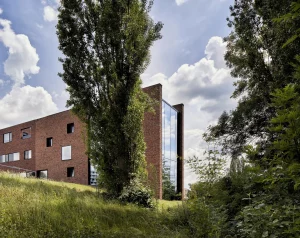The rise of artificial intelligence in architecture is being a fascinating journey, filled with promise but also with pressing questions about sustainability. AI has the potential to reshape how we design, model, and plan our built environments. Yet, there’s still an unsettling issue to be resolved: the immense energy demand of AI systems. Can we truly integrate AI into sustainable construction, or are these two concepts fundamentally at odds?
A couple of months ago I came across a post by Patric Hellermann on Linkedin, and learned about a study comparing the energy use of AI to that of human brains in architectural modeling. Results showd that to model a basic home using AI consumes as much energy as running an oven for 5,249 hours straight. Meanwhile, the human brain accomplishes the same task with the energy equivalent of running the oven for just six hours. On an energy efficiency scale, our brains outperform AI by 875 times. This isn’t a minor gap, it’s a chasm.
The comparison doesn’t stop at energy use. When factoring in costs, AI appears cheaper on the surface, particularly for straightforward projects:
- Simple home: $5,000 (AI) vs. $11,000 (human)
- Six-unit building: $14,000 (AI) vs. $34,000 (human)
- Office building: $68,000 (AI) vs. $160,000 (human)
- Airport: $341,000 (AI) vs. $800,000 (human)
However, these numbers show the cost of 1 single AI iteration. Therefore, if we read into the numbers carefully, cost savings only apply when AI nails the design within the first two iterations. If more iterations are needed, the cost advantage of AI disappears, making human power more cost-effective.

So, do AI and sustainable construction align? The answer lies in how we benefit from AI while addressing its limitations. Here are some of my own personal opinions:
- AI’s energy consumption makes it poorly adapted for detailed, iterative designs or highly complex projects. It shines in generating low-level-of-detail concepts quickly when given the right amount of context and prompts, which can guide initial feasibility studies. Think generic residential or small-scale commercial projects where designs are more standardized.
- In the same line of thought, instead of using AI for entire models, it could focus on very specific areas like structural optimization, energy modeling, or daylight analysis. Moreover, it could be used as a result reader for market simulation tools that does not even do the simulation, but only reads results and gives you recommendations. This targeted use can provide sustainability benefits without the prohibitive energy costs of full-model generation.
- As is often the case, my guess is that the answer will lie in a proper balance between human power and AI. The right mindset will be to integrate AI as one more work tool, rather than a human replacement. AI can generate first-pass, generic models or specific design components, with humans refining details. This approach takes advantage of AI’s speed while reducing its energy use and maintaining precision for detailed designs.
- The current energy-intensive nature of AI hopefully won’t be a permanent roadblock. Rapid advancements in hardware design, such as more energy-efficient processors, and breakthroughs in algorithms optimized for lower power consumption, could significantly reduce the energy demands of AI systems. Additionally, the rise of sustainable, energy-efficient data centers powered by renewable energy sources has the potential to further close the energy gap, making AI more compatible with sustainability goals in the near future.
Overall, AI excels in speed but falls short in adaptability, creativity, and the precise understanding of human needs. Addiotionally, human brains remain vastly more energy-efficient for the time being. All things considered, the evidence suggests that AI and sustainable construction don’t naturally align—yet. The energy-intensive nature of AI presents a clear conflict with the sustainability goals of the construction industry. However, a balanced approach offers a way forward. Hybrid workflows, targeted AI applications, and innovations in energy efficiency could make AI an asset rather than a liability. Ultimately, the future of AI in construction won’t lie in replacing humans but in complementing them. By leveraging the strengths of both AI and human creativity, we can design buildings that are not only functional and beautiful but also sustainable—both environmentally and energetically.
The question we need to keep asking isn’t whether AI can fit into sustainable construction, but how we’ll make it fit.



